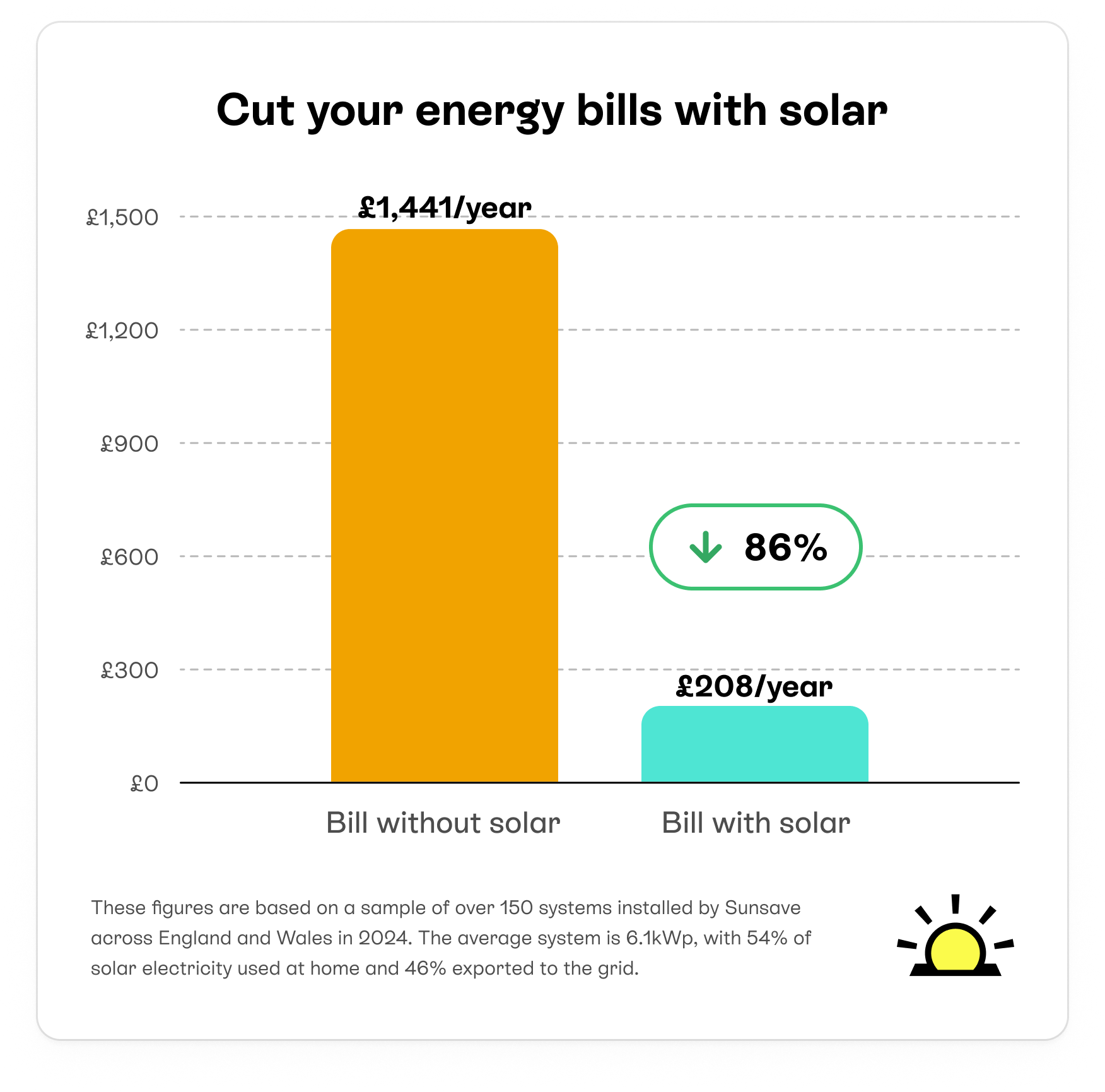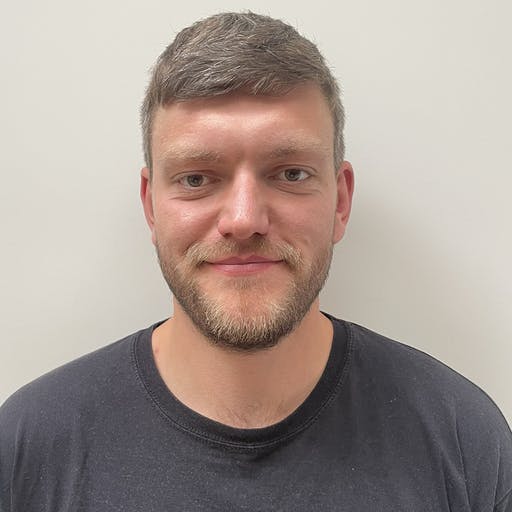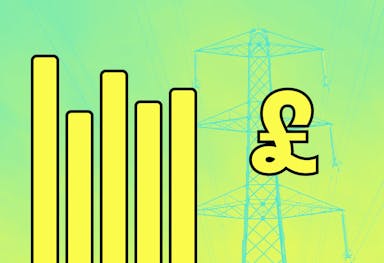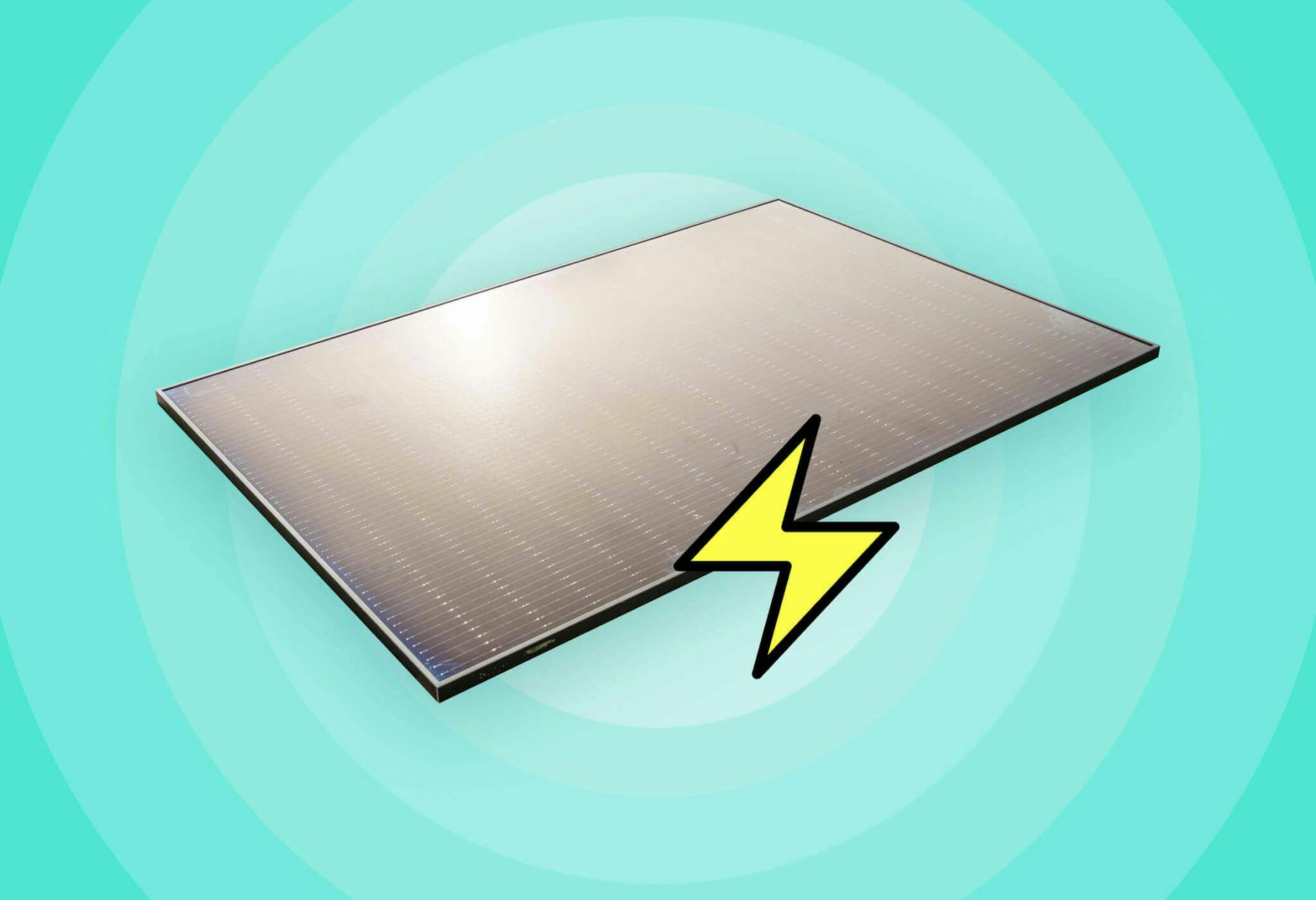- Solar advice hub
- System-size
- How many solar panels do I need?
How many solar panels do I need?
Here’s how to work out how many solar panels you need for your home, and the key factors to consider.


Why you can trust our content
We know that the solar industry is full of misinformation, but we only use reliable sources, including:
- Our experienced solar experts, installers and system designers
- Our own database of solar & battery system designs
- Authoritative bodies like MCS and the UK government




Calculate savings
What kind of home do you live in?
Calculate savings
What kind of home do you live in?
Solar panel system sizing: at a glance
When you're investing in solar for your home, you want to choose the right number of panels.
A system usually costs thousands of pounds upfront, and getting the size wrong can either inflate this cost further or needlessly limit your energy bill savings.
In this guide, we’ll explain how to calculate the number of solar panels you need, as well as how various factors affect the calculation.
To find out how much a solar & battery system could save you in the long run, enter a few details below and we'll provide an estimate.
Find out how much you can save
What kind of home do you live in?
How many solar panels do you need for your home?
The average household will usually need nine or 10 solar panels.
This should create a system that produces roughly as much electricity as your home consumes each year – though to maximise your savings and earnings, you’d ideally cover your roof with panels.
And if you're not an average home, how many panels you need depends on how much electricity your household consumes per year, and whether that figure's likely to rise in the near future.
Once you've worked that out, you should be able to calculate how much solar panels would save you on your energy bills.
This table should give you a sense of how many panels are required for households with different levels of electricity consumption, though it's only a rough guide.
We've used 450-watt (W) solar panels, but the size of panel used by different installers will vary.
The number of panels you need will differ depending on a wide range of factors, including the panels' size, your roof's characteristics, how much sunlight your home gets, and your present (and future) electricity usage.
The exact number of panels you need will be best identified during a consultation with an installation expert.
How to calculate how many solar panels you need
To calculate roughly how many solar panels you need, the only piece of information you need to find is your annual electricity usage, which your energy supplier will usually share with you each year.
If you have an online account with your supplier, you may also be able to find your annual consumption that way. Otherwise, get in touch with the company.
Once you've found it, all you have to do is divide this number by 383, which is the typical annual output in kilowatt-hours (kWh) of a standard 450W solar panel in the UK.
That'll give you a rough estimate of how many solar panels you need.
However, if you haven’t been with the same supplier for at least 12 months – or if you've only recently moved into your home – you’ll need to use an alternative method.
Unfortunately, it’s not as simple as multiplying your last month’s usage by 12, as you'll use much more electricity in some months than in others. Your winter usage will typically be higher than your summer consumption, for instance.
The best approach is to find out your consumption in two separate months: one in summer and one in winter. Then all you need to do is add them together and multiply the result by six to get your approximate annual usage.
After that, it's once again just a matter of dividing by the average amount of kWh generated by a 450-watt panel, which is 383, and finding the nearest whole number.
Solar panel calculator
This solar panel calculator can help you quickly work out roughly how many panels you should get for your home.
It works best if you know how many electricity your household uses per year, which you can get from your supplier – either through your online account, or in a physical bill.
If you have no idea though, that's also fine: we'll just ask you a few questions to get an idea of your usage, including whether you have a heat pump or electric vehicle charger.
We'll then rely on the average UK solar irradiance to work out the number of panels needed to meet this consumption level.
The result you get from this calculator is just a rough indication based on your usage.
For a more accurate proposal that’s tailored to your needs, enter your details below and one of our solar specialists will be in touch.
Find out how much you can save
What kind of home do you live in?
Will you still need to buy electricity from the grid?
The solar electricity your system generates each year won't usually line up with when you actually use the most electricity.
Solar panels generate much more electricity in summer than they do in winter, at least in the northern hemisphere.
This contrasts with the way households typically use electricity, which is relatively stable, with a peak in winter and a dip in summer.
So even if your system produces all the electricity you need over the course of a year, you may not be able to use it all – though a solar battery does help.
You'll usually rely on the grid for some of your electricity in winter, and export a large proportion of your solar electricity in summer.
You can earn money for this excess energy with a solar export tariff – and to choose the right tariff for you, check out our guide to the best solar export tariffs.
On average, you could save 86% on your electricity bills with a solar & battery system.

What’s the minimum number of solar panels needed?
We generally recommend a minimum of six solar panels in order to make meaningful savings on your energy bills. With 450W panels, this would form a 2.7kWp system.
However, it's almost always worth getting as large a system as you can. Extra panels don’t tend to add much to your overall cost, but they can significantly boost your savings.
There’s no maximum number of solar panels you can install, so it's just a matter of how much space you have.
With a large system, you’ll generate excess electricity that you can sell to the grid. Export tariffs can already earn you hundreds of pounds per year, and they're getting increasingly profitable.
With systems lasting 30-40 years, you’ll also be protected against energy price rises and prepared for a future that may include an EV charger, heat pump, or air conditioning.
To find out more, check out our full guide: 4 reasons to get a larger solar panel system.
Verified expertThe vast majority of sloped, residential roofs in the UK are strong enough to support a solar panel system, so there are normally no risks associated with adding lots of panels. It’s only once you go over around 25 panels that it’s worth considering an additional structural survey.
Tom Brehme
Technical Manager at Sunsave
Tom has worked in residential solar installation for more than a decade, and is a fully qualified electrician.
What’s the average number of solar panels per home?
The average solar panel system size in 2024 was 5.5kWp, according to Ofgem.
With 450W panels, this would make 12 the rough average.
However, many customers opt to cover their roof, to generate as much electricity – and as much income – as possible.

Average residential solar panel system size UK, 2020-24
The chart below shows how the average size of a residential solar panel system in the UK increased between 2020 and 2024, based on data from Ofgem's annual SEG reports.
This trend towards larger system sizes displays a growing appetite for bigger arrays across the country, but is also indicative of advances in solar technology.
The average number of panels in a system has probably stayed roughly the same, as households still have a limited amount of roof space – but panels have become increasingly powerful.
Solar panel system sizes around the UK
Below are some solar PV system designs that Sunsave designed and installed in 2024 at homes across the country, all of which show large savings on their electricity bills.
Some of the designs include more panels than the household would require to match its consumption, because it’s best to make the most of your roof space.
After all, larger solar panel systems produce more savings, since you can just sell all your excess electricity to the grid on an export tariff.
Verified expertIt’s possible to add more solar panels to your system later on, however it often requires additional work such as upgrading the inverter and/or rewiring the system, and you’ll also be paying for another round of scaffolding and labour. The most sensible approach from a financial perspective is to maximise your roof space the first time around.
Alfie Ireland
Head of Operations & Technical at Sunsave
Alfie has worked in green tech for over a decade. During his four years at OVO, he helped develop the world’s largest domestic vehicle-to-grid trial.
What factors affect how many solar panels you need?
Here’s a list of factors that usually affect the number of solar panels you’ll need to power your home:
- Your electricity consumption
- If your electricity consumption is going to increase soon
- The direction and angle of your roof
- Where in the UK you live
- The efficiency of your solar panels
1. Your electricity consumption
This is the main factor that'll help you work out how many solar panels you should get.
Your system should generate roughly as much electricity per year as you currently consume at home.
Even with a battery, you won't be able to use all the solar electricity your panels produce – as they'll generate so much more in summer than in winter – but sizing your system in this way helps to maximise your profits.
2. If your electricity consumption is going to increase soon
If you’re expecting to increase your electricity consumption in the near future, it's worth considering getting a larger solar panel system to meet that rise in demand when it happens.
Adding a heat pump or an electric vehicle charger, for example, will be better with a sizable solar panel system to help cover the increased energy consumption.
A heat pump for a three-bedroom household typically adds 3,200kWh to your total annual consumption, while an electric vehicle and charger will add around 2,000kWh, on average.
However, bear in mind that technology such as heat pumps and EV chargers use a lot of electricity.
Even a large solar & battery system will struggle to cover the majority of your electricity needs, so you'll still have to rely on the grid for some power, especially in the winter months.
For more information, read our guide to how the UK's electricity consumption level is increasing.
3. The direction and angle of your roof
The direction your solar panels face affects the quantity of electricity they can generate – as does the angle they’re installed at.
If you live in the UK, you’ll ideally want to have your solar panel system facing south, at an angle between 30° and 45°.
The further you are from this ideal situation, the more solar panels you’ll need in order to achieve the required quantity of electricity.
You can still generate lots of electricity throughout the year with an east-facing or west-facing solar panel system, but it’ll need more panels than a south-facing system to achieve the same output.
And if you have a large south-facing roof that comes with various obstructions – such as chimneys, skylights, and vent pipes – that cast areas of the roof in shade, you may have to use more panels on other sides of your roof to reach your desired output goal.
If you have a flat roof, you can achieve the optimal angle with a mounting system to prop the solar panels up, though most residential flat roofs in the UK aren't strong enough to support a solar array.
Since drilling into a flat roof is usually a bad idea, the system will need ballasts to secure it to the roof, which weigh around 80kg per panel.
This will usually make an array with 12 solar panels around five times heavier, which is too much for the average roof.
Check out our article on whether your roof is suitable for solar panels to find out more.
4. Where in the UK you live
Despite the UK’s comparatively small physical size in global terms, there’s a surprisingly large variation in the amount of sunshine hitting different parts of the country. And this, of course, will affect how many solar panels you need in order to meet your consumption levels.
You won’t be surprised to read that the more southerly parts of the UK, like Cornwall, Dorset, and Essex receive more solar irradiance than the northern parts.
For instance, the south of England typically sees around 128 watts per square metre (W/m2) of solar irradiance each year , whilst the northwest of Scotland sees just 79W/m2.
Receiving less solar irradiance obviously means you’ll need more panels on your roof to achieve the same power generation as those basking in higher quantities.
5. The efficiency of your solar panels
Some solar panels are much more efficient than others, which can greatly affect how many you need.
A panel's efficiency directly equates to how much electricity it can produce per square metre (m²).
For example, the 24.8% efficient LONGi Hi-MO X10 Scientist generates 248W of capacity per m² in standard test conditions. That's 43W more than the 20.5% efficient REC N-Peak 2.
With a 10-panel system, that's a 430W gain. In the UK, this will let you generate 366kWh more per year, on average – and if you use that to replace grid electricity, it'll save you about £100 extra.
So the more efficient your panels are, the more you'll save.
This is particularly important if you have limited roof space, but higher efficiency panels can boost your returns in any scenario.
The most efficient solar panels all have ratings above 20%, which means they turn more than one-fifth of the natural light they receive into electricity.
Advances in the field are very gradual though, with companies making marginal gains every year or two.
Does a battery change how many solar panels you need?
A battery doesn’t change how many solar panels you need, no matter its size.
However, it allows you to make the most of your panels, both because you can use even more of the electricity they produce, and because you can take advantage of better export and import tariffs.
These include high-paying export rates like Good Energy Solar Savings and Octopus Flux. You may also be able to sign up for Good Energy Solar Savings Exclusive or Intelligent Octopus Flux, though these tariffs come with extra requirements.
You can also get on a time of use import tariff that include generous off-peak periods, like British Gas Electric Driver or Intelligent Octopus Go.
These tariffs, which were designed for electric cars but are open to all customers, allow you to fill your battery with cheap electricity that could power your home for the rest of the day – potentially saving you hundreds of pounds per year.
To learn more, read our guide to deciding what size solar battery you need.
Limitations on the number of solar panels you can have
Legally, there’s no maximum number of solar panels allowed in the UK, but all roofs come with physical limits.
When you’re trying to fit as many solar panels on your roof as you can, there are a couple of main factors that can put a ceiling on your ambitions.
There isn’t much you can do about either of these issues, but the more you know, the better prepared you’ll be.
Roof space
The more solar panels you get, the bigger your roof has to be to fit them.
A panel is usually around 2m², but your installer will need to leave room either side of each panel, and around the system as a whole.
They’ll typically leave 40cm of space on all sides, and at least 3cm between the panels, to match the standards created by bodies like Microgeneration Certification Scheme (MCS) and Flexi-Orb.
This all means that each panel requires more than 3m² – for example, if your installer plans to put 10 solar panels on your roof, they’ll need 31.79m² of space.
And if your roof has extra facets, such as a chimney, skylight, or vent pipe, this will also reduce the amount of usable roof space.
If you're left wanting by the available space on your main roof, you should consider putting some panels on your garage roof.
To learn more, check out our guide to whether your roof would be suitable for solar.
Roof strength
A typical solar panel weighs 20kg, or 10kg per square metre.
This is well within the capabilities of most pitched roofs, which can generally hold many times this weight.
However, flat roofs are more problematic. Installers don’t usually drill into flat roofs, since holes can result in leaks, so they’ll ballast your panels – but ballasts weigh around 80kg per panel.
Roughly speaking, this will multiply your solar panel system’s weight by five, so a 10-panel system will go from about 200kg to a tonne. This normally means solar panels aren’t suitable for flat roofs.
DNO permissions
If your solar inverter has a maximum capacity higher than 3.68kW, your installer must ask permission from your region’s Distribution Network Operator (DNO) – that is, the body that runs the hardware supplying your area of the UK with electricity.
They’ll do this by sending in a G99 application. If your DNO gives its approval, you can make full use of your system. Otherwise, you may have to limit your inverter’s capacity to 3.68kW.
You could still have as many panels as you want, but if you’re planning to get a large system and sell lots of electricity to the grid, getting a G99 in advance is a must – or much of your excess electricity will go to waste.
Most solar panel systems come with an inverter that has a capacity under 3.68kW. These households are allowed to proceed with their solar installation, then send a G98 form to their DNO within 28 days of the system being commissioned.
How many solar panels do you need to live off grid?
You won't be able to power your entire off-grid setup with solar panels unless you massively reduce your electricity consumption in winter, to match the seasonal decrease in your panels' output.
However, solar panels can still form a large part of your electricity supply.
In order to work out how many solar panels you should get to help power your off-grid life, you'll need to know your annual electricity consumption.
You can also adjust this total based on need – so if you don't fancy paying for a large number of panels, you can cut down on the number of electrical items you use.
If you're successful in minimising your electricity consumption to – for example – 1,200kWh, you may only require three solar panels to power a large chunk of your electrical needs.
Next steps
You now have the tools you need to work out how many solar panels you should get for your home.
This means you’re one step closer towards lower energy bills, reduced carbon emissions, and less reliance on the grid.
To find out how much a solar & battery system could save you in the long run, enter a few details below and we'll provide an estimate.
Find out how much you can save
What kind of home do you live in?
FAQs
Related articles

Written byJosh Jackman
Josh has written about the rapid rise of home solar for the past six years. His data-driven work has been featured in United Nations and World Health Organisation documents, as well as publications including The Eco Experts, Financial Times, The Independent, The Telegraph, The Times, and The Sun. Josh has also been interviewed as a renewables expert on BBC One’s Rip-Off Britain, ITV1’s Tonight show, and BBC Radio 4 and 5.











